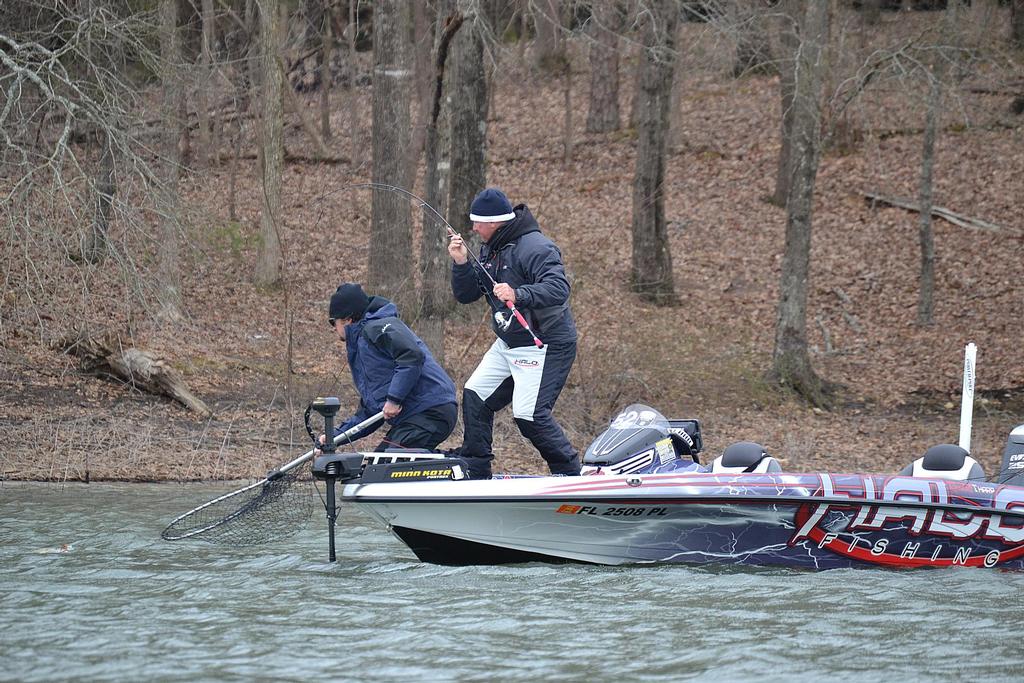5 Techniques That Catch Bass Now

Don’t let the chill of Jack Frost dissuade you from getting out on the lake this winter. Fish are still catchable, and bass will often congregate in schools this time of year, so the action can be faster than you’d expect once you find them. These five FLW anglers who regularly brave the cold tell us where to look and how to catch them.
1. Matt Arey
Fishing points with a drop-shot on Lake Norman
When winter arrives at Lake Norman in North Carolina, Matt Arey commonly targets bass on main-lake points with a drop-shot.
“Points that have the channel swinging into the bank are usually the best this time of year,” Arey adds.
The key is to pay close attention to the depth finder.
“I’m usually fishing in 25 to 45 feet of water this time of year,” Arey says. “I’ll look for suspending bass with my graph. You’ll often find them in the channel itself, or close by.”
Once Arey locates fish, he fishes the drop-shot vertically, watching it drop to the fish on his graph and keeping it slow because fish are lethargic.
“Even though I’m fishing slow, these bass school up, and you can catch a lot of them,” he adds.
2. Stacey King
Fishing channel banks with the umbrella rig on Table Rock Lake
When fish move into the upper reaches of the various creeks and rivers of Table Rock Lake in the fall, they generally tend to stay there for the winter. Once water temperatures dip below 60, Stacey King says the best way to catch them is with an umbrella rig.
“I like to look for channel banks with flooded timber up in the creeks,” King says.
He retrieves the rig over the tops of flooded trees to catch suspended bass. Despite the low temperatures, King never slows down and is always on the move.
“If I pull up to a channel bank and don’t get bit throwing the umbrella rig, I just move on to the next one,” he explains. “I know it’s only a matter of time before I pull up on the right spot and get bit, so I’m not afraid to cover a lot of water with this technique.”
3. Randall Tharp
Fishing the tailrace with a spinnerbait in Tennessee or Alabama
Randall Tharp says some of the most exciting fishing he’s ever encountered was when he fished some of the many tailraces in Tennessee and Alabama during the winter months.
“Even though it’s cold, the oxygen content of tailrace waters keeps the fish extremely active in the winter, and the action can be very fast,” he says. “I’ve caught some amazing stringers of spotted bass this time of year.”
When fishing the tailrace in the winter, Tharp looks for current breaks and eddies and makes repeated casts to these areas with a spinnerbait.
“Once you find a good-looking break or eddy, you can’t just make one cast with your spinnerbait,” he explains. “It might take dozens of casts and retrieves until you find how the bass want the spinnerbait. Once you get bit, however, be sure to make the same cast because you’re going to catch more.”
Even though it’s cold, don’t think you have to fish your spinnerbait slow. Fish are often active in the moving water, so experiment with faster retrieves as well.
4. Dan Morehead
Fishing ledges with a flat-tail grub on Kentucky Lake
Dan Morehead catches a lot of bass on Kentucky Lake in the wintertime by fishing ledges near the mouths of bays. He fishes 15 feet deep or deeper, and one of his favorite ways to catch fish this time of year is with a technique that his late father, Charles “Doc” Morehead, passed down to him: aggressively fishing a flat-tail grub on a 1/4-ounce jighead.
“Even though fish are sluggish, I’ll fish a small flat-tail grub almost like you would stroke a jig,” Dan says. “Popping this grub off the bottom will cause lethargic fish to react. I generally don’t look to fish the grub vertically, though you can fish it that way if necessary.”
Morehead fan-casts around these ledges, letting his flat-tail grub sink to the bottom. Fish will often take the grub on the initial fall, and the bite will be subtle, so line-watching is important for detecting bites. Once the grub reaches the bottom, Morehead commences with his pop-fall-pop cadence.
5. Clark Reehm
Fishing secondary points with a spoon on Sam Rayburn
Clark Reehm begins his wintertime search by scanning secondary points with his depth finder. The goal is to locate active fish, and if he doesn’t mark anything, he immediately moves on to the next location. Once Reehm finds schooling fish, he likes to throw a big 7/8-ounce spoon to catch them.
“Throwing a spoon is a great way to get fish to bite this time of year because it causes them to react,” says Reehm. “I pay attention to where the fish are staged on my graph and fish accordingly. I’ll pop my spoon up off the bottom, or I’ll make a cast and worm the spoon back to the boat.”
Once the first fish bites, it often will cause the rest of the school to go into feeding mode, so it’s important to get the spoon back into the school quickly after the first catch.